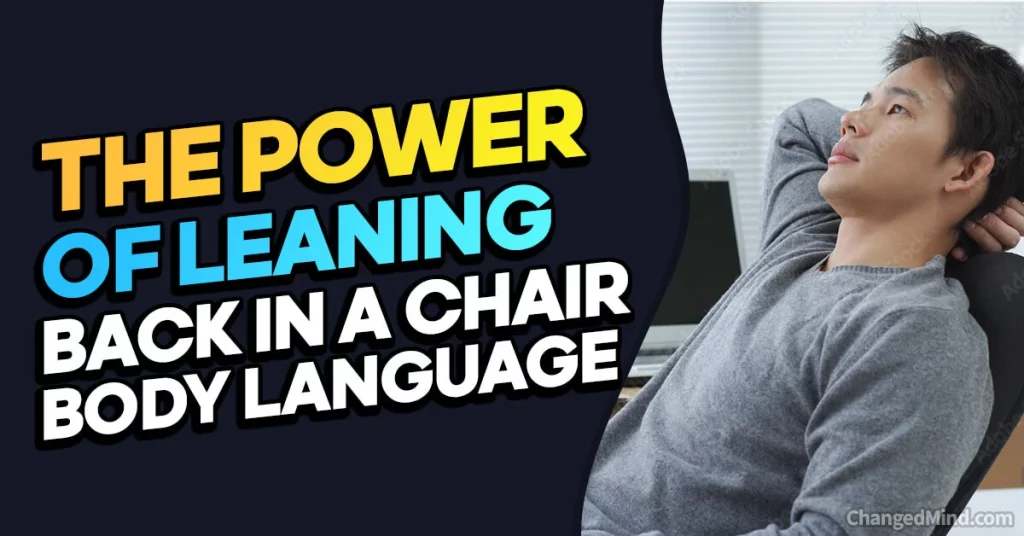Have you ever noticed how someone’s body language can speak volumes without them uttering a single word? Well, you’re about to delve into a fascinating aspect of non-verbal communication: “Leaning Back in a Chair body language.” It’s a subtle yet powerful signal that can reveal a lot about a person’s thoughts, feelings, and intentions.
Picture this: You’re in a meeting, and someone leans back in their chair, arms crossed, wearing a relaxed smile. What does it mean? In this article, we’ll unravel the secrets behind this intriguing body language cue.
Here’s a sneak peek of what we’ll explore:
- The Relaxed Lean-Back Stance: What it signifies and when it’s used.
- Confidence and Control: How leaning back can convey authority.
- Emotional Insights: What subtle clues can be gleaned from this posture.
- The Flip Side: When leaning back might indicate disinterest or detachment.
- Mastering Leaning Back: Tips on how to use this body language effectively in various situations.
So, if you’re eager to decode the unspoken messages hidden in the simple act of leaning back in a chair, you’re in for an eye-opening journey. Let’s uncover the power of non-verbal communication together!
The Power of Body Language
Did you know that only a small percentage of communication is actually conveyed through words? Body language plays a significant role in our interactions, often revealing more about our thoughts and feelings than our verbal expressions alone.
By understanding and interpreting body language, you can gain valuable insights into the intentions, emotions, and dynamics of those around you.
Leaning Back in a Chair: An Intriguing Gesture
Picture this: you’re in a meeting or social gathering, and someone leans back in their chair, appearing at ease and exuding a sense of confidence. What does it mean? Leaning back in a chair is a fascinating body language signal that can communicate various messages depending on the context and individual. Let’s dive deeper into the meanings behind this gesture.

The Meaning Behind Leaning Back in a Chair
When you observe someone leaning back in a chair, it’s like peering into their unspoken thoughts and intentions. Let’s explore the various meanings behind this intriguing body language gesture.
Conveying Confidence and Authority
Imagine a scenario where you’re sitting in a meeting, and a colleague leans back in their chair while expressing their ideas. That slight backward tilt can convey a sense of confidence and authority. It’s as if they’re saying, “I’m in control, and I have the knowledge and expertise to handle this.”
By leaning back, they create an impression of self-assuredness, which can influence how others perceive them. It’s a subtle power move that commands attention and respect. So, next time you find yourself in a professional setting, consider incorporating this gesture to boost your presence and assertiveness.
Demonstrating a Relaxed and Non-Threatening Posture
Leaning back in a chair can also create a relaxed and non-threatening atmosphere, making it easier for others to approach and engage in conversation. When you lean back slightly, you’re signaling openness and receptiveness. It’s like saying, “I’m comfortable, and I’m here to listen.”
Expert Says
Silvi Saxena, MBA, MSW, LSW, CCTP, OSW-C
Licensed Social Worker | Certified Clinical Trauma Professional, Choosing Therapy

This posture can help foster connections and build rapport with others. By creating an inviting space for interaction, you encourage meaningful exchanges and allow people to feel more at ease in your presence. So, the next time you’re at a social gathering or having a casual conversation, lean back and create an environment that encourages communication.
Signifying Disinterest or Detachment in Certain Contexts
While leaning back in a chair often conveys confidence and relaxation, it’s crucial to consider the context. In some situations, this body language gesture can indicate disinterest or detachment.
For example, picture a scenario where someone is listening to a tedious monologue or enduring a long-winded presentation. If they lean back excessively, it could imply a sense of boredom or a desire to detach from the conversation. In such cases, it’s important to be mindful of your body language and ensure it aligns with your intended message.
Remember, body language is a nuanced form of communication, and the interpretation of gestures can vary based on the specific context and individual. Being aware of these potential interpretations allows you to navigate social situations more effectively.
Now that we’ve delved into the meanings behind leaning back in a chair, let’s explore how this body language gesture manifests in different settings, from professional interactions to social dynamics and romantic relationships.
Leaning Back in Business and Professional Settings

In the world of business and professional interactions, every gesture and posture can make an impact. Leaning back in a chair during meetings and negotiations can have significant implications, influencing how others perceive your power and control in the situation.
Implications of Leaning Back during Meetings and Negotiations
When you lean back in a chair during a meeting or negotiation, it sends a message that you are comfortable and self-assured. This posture can create an aura of confidence and establish your presence in the room. It conveys that you are in control of the situation and ready to make informed decisions.
Furthermore, leaning back can also signal that you are open to hearing different perspectives and considering alternative viewpoints. It shows that you are receptive to ideas and willing to engage in constructive dialogue. By adopting this posture, you encourage collaboration and foster an environment of mutual respect.
The Perception of Power and Control
Leaning back in a chair can influence how others perceive your power and control in a professional setting. This gesture conveys a sense of authority and can position you as a leader. When you lean back with poise, it creates an image of someone who is confident and capable.

Additionally, this body language can establish a power dynamic within the room. It can subtly convey that you hold a position of influence and that your opinions and contributions are significant. However, it’s important to strike a balance and ensure that your body language does not come across as overbearing or dismissive.
Tips for Utilizing Leaning Back to Establish Credibility
To effectively utilize leaning back in a chair to establish credibility, consider the following tips:
- Observe the Context: Be mindful of the specific setting and adjust your body language accordingly. Leaning back might be more appropriate in informal meetings or when fostering a collaborative atmosphere.
- Maintain Good Posture: While leaning back, maintain good posture to project professionalism and confidence. Slouching or appearing too relaxed can undermine your credibility.
- Engage Actively: Despite leaning back, actively participate in the discussion. Show your engagement through attentive listening, thoughtful responses, and maintaining eye contact.
- Be Mindful of Nonverbal Cues: Pay attention to other nonverbal cues, such as facial expressions and hand gestures, to ensure they align with your intended message. Consistency in your body language reinforces your credibility.

Remember, the key to leveraging leaning back in a professional setting is to strike a balance between confidence and approachability. By mastering this body language skill, you can establish yourself as a credible and influential presence in the business world.
Now that we’ve explored the implications of leaning back in professional settings, let’s move on to its role in social interactions and its impact on relationship dynamics.
Leaning Back in Social Interactions
Leaning back in a chair isn’t just reserved for business settings—it also plays a fascinating role in social interactions. Whether you’re attending a social gathering or engaging in casual conversations, understanding the implications of leaning back can help you navigate these situations with finesse.
Leaning Back in Social Gatherings and Casual Conversations
When you find yourself in a relaxed social setting, leaning back in a chair can create an atmosphere of comfort and informality. It’s like giving a signal that you’re ready to engage in friendly banter and enjoy the company of others. By adopting this posture, you invite others to join in and contribute to the conversation.

In a casual setting, leaning back can also help establish a sense of camaraderie and relaxation. It sets the tone for a more laid-back interaction, allowing everyone to unwind and feel at ease. So, the next time you’re catching up with friends or attending a social event, consider leaning back to create a welcoming ambiance.
Creating a Comfortable and Inviting Atmosphere
Leaning back in a chair sends a nonverbal message that you are approachable and open to conversation. It breaks down the invisible barriers that sometimes exist in social interactions, allowing others to feel comfortable and at liberty to share their thoughts. This gesture shows that you’re ready to listen and connect with those around you.
By creating an inviting atmosphere through your body language, you encourage others to feel heard and valued. This fosters meaningful connections and strengthens relationships. So, don’t be afraid to lean back and create a warm and inclusive space for social interactions.

Nonverbal Cues for Active Listening while Leaning Back
While leaning back in a chair, it’s important to remember that active listening is still paramount. Despite the relaxed posture, your nonverbal cues should indicate that you are engaged and attentive to the speaker. Here are some tips for active listening while leaning back:
- Maintain eye contact: Lock eyes with the speaker to show that you are fully present and interested in what they have to say.
- Nod and smile: Use subtle nods and genuine smiles to acknowledge the speaker and provide encouragement.
- Lean forward when necessary: While primarily leaning back, don’t hesitate to lean forward slightly to convey your interest and involvement in the conversation.
- Avoid distractions: Minimize distractions, such as checking your phone or looking around the room, to demonstrate respect for the speaker and the conversation.
By combining the relaxed posture of leaning back with these active listening cues, you can create a harmonious balance between comfort and engagement.

Now that we’ve explored the impact of leaning back in social interactions, let’s delve into its role in romantic relationships and dating dynamics.
Leaning Back in Romantic Relationships and Dating
Ah, the thrilling realm of romantic relationships and dating. Leaning back in a chair can have a tantalizing effect when it comes to attraction, seduction, and the subtle dance of courtship. Let’s explore the intriguing role of leaning back in this captivating domain.
The Role of Leaning Back in Attraction and Seduction
When it comes to attracting a potential partner, body language can speak volumes. Leaning back in a chair can exude an alluring aura, drawing others in and piquing their interest. It’s like casting a magnetic spell that says, “I’m confident, and I’m worth getting to know.”
This posture creates a sense of intrigue and mystery, leaving room for others to wonder about you and yearn for more. It can be an excellent strategy for sparking initial attraction and capturing someone’s attention. Just remember that body language is just one piece of the puzzle, and genuine connection and compatibility are vital for long-term relationships.

Sending Signals of Confidence and Self-Assurance
Leaning back in a chair can be a powerful way to signal confidence and self-assurance. When you recline with poise, it conveys a message that you are comfortable in your own skin and secure in who you are. This type of nonverbal confidence is incredibly appealing to others.
By adopting this posture, you show that you value yourself and your own space. It demonstrates that you are not overly needy or desperate for validation. Confidence is undeniably attractive, and leaning back can help you radiate that magnetic self-assurance.
Using Leaning Back as a Strategy to Create Intrigue and Interest
Strategic use of leaning back in a chair can create an air of intrigue and captivate the curiosity of your potential romantic interest. By employing this gesture strategically during a date or conversation, you create a subtle element of mystery and draw the other person towards you.
Imagine leaning back, maintaining eye contact, and engaging in a deep and meaningful conversation. This combination sends powerful signals of confidence, engagement, and genuine interest. It can create a captivating dynamic, making the other person feel seen and appreciated.

Remember, the art of leaning back in romantic relationships and dating is about balance. It’s a delicate dance between showing interest and maintaining an aura of independence. Mastering this balance can create an irresistible allure that keeps your partner intrigued and wanting more.
Now that we’ve explored the role of leaning back in romantic relationships, let’s shift our focus to the importance of context and cultural differences in interpreting body language.
The Importance of Context and Cultural Differences
As we explore the nuances of leaning back in a chair and its significance in body language, it’s essential to recognize that these cues may vary across cultures. Understanding the role of context and individual differences in interpreting leaning back is crucial for accurate communication and avoiding misunderstandings.
Recognizing that Body Language Cues May Vary Across Cultures
Body language is not a universal language. Different cultures have their own unique set of nonverbal communication cues and interpretations. Leaning back in a chair, which may convey confidence or relaxation in one culture, might hold a different meaning in another.
For instance, in some cultures, leaning back excessively may be perceived as disrespectful or arrogant. It’s important to educate ourselves about cultural norms and customs when interacting with individuals from different backgrounds. This awareness helps us navigate social interactions with sensitivity and respect.
Considering the Context and Individual Differences in Interpreting Leaning Back
Beyond cultural variations, it’s crucial to consider the context and individual differences when interpreting leaning back in a chair. Body language is highly contextual, and the same gesture can have different implications based on the specific situation and the people involved.
A person leaning back during a casual conversation with friends might be simply expressing comfort and relaxation. However, if the same gesture occurs during a serious discussion, it could be interpreted as disinterest or detachment. It’s essential to assess the overall communication dynamics and take into account the person’s behavior as a whole.
Additionally, individual differences play a role in interpreting body language. People have their unique preferences, comfort levels, and personal habits that can influence how they use and perceive leaning back. It’s crucial to avoid making sweeping generalizations and instead focus on observing individual cues and adjusting our own behavior accordingly.
By recognizing the importance of context and cultural differences, we become more attuned to the intricate tapestry of nonverbal communication. This understanding allows us to navigate social interactions with empathy, adaptability, and open-mindedness.
Now that we’ve explored the significance of context and cultural differences, let’s conclude our journey through the world of leaning back in a chair and its impact on communication dynamics.
Tips for Incorporating Leaning Back in Your Body Language
Now that you understand the intriguing role of leaning back in a chair and its impact on communication, you might be wondering how to effectively incorporate this body language into your own interactions. Fear not! Here are some practical tips to help you master the art of leaning back with finesse.
Practicing Proper Posture and Balance
When leaning back in a chair, it’s important to maintain proper posture and balance. Here’s how you can do it:
- Sit up straight: Start with a good sitting posture by aligning your spine and keeping your shoulders relaxed. This sets a solid foundation for leaning back comfortably.
- Engage your core muscles: Activate your core muscles to maintain stability and balance as you lean back. This helps you avoid any awkward or unsteady movements.
- Distribute your weight: Shift your weight evenly between your back and your seat to ensure balance and avoid tipping over. Find that sweet spot where you feel relaxed and supported.
Remember, proper posture not only enhances your body language but also contributes to your overall confidence and well-being.
Using Gradual Movements to Lean Back Comfortably
When leaning back in a chair, it’s best to do so gradually and smoothly. Sudden or abrupt movements can come across as jarring or distracting. Follow these steps for a comfortable lean back:
- Start in an upright position: Begin by sitting upright, with your back against the chair and your feet planted firmly on the ground.
- Relax your upper body: Loosen your muscles and let go of any tension. Relax your shoulders, neck, and arms.
- Lean back gradually: Slowly shift your weight backward, allowing your chair to support you. Maintain control and move at a pace that feels natural to you.
- Find your balance: Once you’ve leaned back to a comfortable position, settle in and adjust your posture if needed. Remember to stay balanced and centered.
By practicing gradual movements, you can convey a sense of ease and relaxation, enhancing the impact of your body language.
Being Mindful of Overdoing or Misinterpreting the Signal
While leaning back in a chair can be a powerful nonverbal signal, it’s essential to be mindful of how it is perceived. Here’s what you should keep in mind:
- Avoid overdoing it: Leaning back too far or for prolonged periods may give off an air of indifference or disinterest. Strike a balance between leaning back comfortably and staying engaged in the conversation.
- Consider the context: Different situations may call for different levels of leaning back. Assess the environment, the people involved, and the overall tone of the interaction to ensure your body language aligns with the desired message.
- Interpret with caution: When observing someone else leaning back, be cautious not to jump to conclusions or make assumptions solely based on this gesture. Take into account other nonverbal cues and the overall context before forming an interpretation.
Remember, body language is just one piece of the communication puzzle. It should be used in conjunction with verbal cues and active listening to foster genuine connections and effective communication.
By incorporating these tips into your body language repertoire, you can leverage the power of leaning back in a chair to enhance your presence, create a comfortable atmosphere, and engage in meaningful interactions.
Leaning Back in a Chair with Hands Behind Head
Leaning back in a chair with your hands behind your head is a body language gesture that often sparks curiosity and intrigue. In this section, we’ll explore the meaning behind this specific variation of leaning back and shed light on its implications in various contexts.
The Impression of Confidence and Relaxation
When you lean back in a chair and rest your hands behind your head, you project an image of confidence and relaxation. This posture suggests that you are comfortable in your surroundings and at ease with yourself. It can signal a sense of self-assurance and a willingness to engage in conversation or listen attentively.
By adopting this body language, you demonstrate an air of authority and establish yourself as a person who is in control of the situation. It exudes a certain level of confidence that can make others perceive you as someone to be taken seriously.
Conveying an Open and Approachable Demeanor
Leaning back in a chair with your hands behind your head also conveys an open and approachable demeanor. It creates an inviting atmosphere and encourages others to feel more comfortable in your presence. This body language can foster a sense of trust and promote open communication.
The posture of leaning back, combined with the gesture of placing your hands behind your head, suggests that you are receptive to ideas, opinions, and different perspectives. It communicates that you are willing to listen actively and engage in meaningful discussions.
Use with Caution: Be Mindful of Context
While leaning back in a chair with hands behind your head can be an effective body language gesture, it’s essential to be mindful of the context in which you use it. Consider the following factors:
- Formal settings: In more formal or professional settings, this posture might be perceived as too casual or even disrespectful. It’s important to adapt your body language to match the level of formality and professionalism required.
- Power dynamics: In situations where there is a significant power imbalance or when dealing with individuals who might feel intimidated, this gesture could reinforce that power dynamic. Ensure that your body language does not alienate or create discomfort for others.
- Active listening: While this posture can indicate attentiveness, be cautious not to appear disengaged or disinterested. Combine it with active listening cues such as nodding, maintaining eye contact, and providing verbal affirmations to show genuine interest.
Ultimately, the key is to strike a balance between projecting confidence and approachability while remaining aware of the social dynamics at play.
Real-Life Example: The Business Meeting
Imagine you are in a business meeting with colleagues or clients. As the discussion progresses, you lean back in your chair with your hands behind your head. This posture conveys that you are confident in your ideas, open to collaboration, and ready to actively listen to others’ perspectives. It sets a tone of approachability and encourages a productive exchange of ideas.
Remember, body language is just one aspect of effective communication. It works in conjunction with verbal cues, active listening, and genuine empathy to create meaningful connections.
What Does Leaning Back in a Chair Body Language Convey?
Leaning back in a chair body language often signifies relaxation and confidence. When someone leans back comfortably, it can suggest that they are at ease with the situation.
Is Leaning Back a Sign of Confidence?
Yes, leaning back in a chair is commonly associated with confidence. It can demonstrate a sense of self-assuredness and control over the environment.
Are There Different Types of Leaning Back Body Language?
Absolutely. Leaning back can have various interpretations depending on the context. It could indicate attentiveness, disinterest, or even boredom.
How Can I Use Leaning Back to My Advantage in a Meeting?
To project confidence and authority, try leaning back slightly while maintaining an engaged posture. It can convey a sense of control and openness to ideas.
What Are the Emotional Insights Revealed by Leaning Back?
Leaning back may indicate comfort, but it can also signal emotional detachment or aloofness. Understanding the context is crucial in interpreting the emotions behind it.
Can Leaning Back Be Misinterpreted?
Yes, leaning back can be misinterpreted if not considered alongside other body language cues and the situation. It’s essential to analyze the broader context.
When Does Leaning Back Suggest Disinterest?
Leaning back can suggest disinterest when combined with other signs like crossed arms or lack of engagement in a conversation.
Is Leaning Back Suitable for All Situations?
Leaning back is context-dependent. In some situations, it’s appropriate and confident, while in others, it may come across as disrespectful.
Can I Use Leaning Back to Build Rapport?
Yes, leaning back can help build rapport when used to signal openness and comfort. However, it should be aligned with the tone of the conversation.
What Are Some Cultural Differences in Interpreting Leaning Back?
Different cultures may interpret leaning back differently. In some cultures, it may be seen as casual, while in others, it might signify disrespect.
Are There Gender Differences in Leaning Back Body Language?
There can be gender differences in the way people perceive leaning back. It’s essential to avoid making assumptions and consider individual preferences.
Can Leaning Back Enhance Leadership Presence?
Yes, when used appropriately, leaning back can enhance leadership presence by conveying confidence, control, and approachability.
What’s the Difference Between Leaning Back and Slouching?
Leaning back implies a deliberate, relaxed posture, while slouching usually signifies poor posture and lack of engagement.
Are There Any Risks in Overusing Leaning Back Body Language?
Overusing leaning back can make you appear too relaxed or disinterested, potentially hindering effective communication.
How Can I Practice Effective Leaning Back Body Language?
Practice being aware of your posture and adjusting it according to the situation. Experiment with leaning back subtly to gauge its impact on your interactions.
Conclusion
Congratulations on completing your exploration of the fascinating world of leaning back in a chair and its impact on body language! Let’s recap the key takeaways from our journey and encourage you to utilize this nonverbal communication tool effectively.
Recap of the Importance of Leaning Back in a Chair as a Body Language Signal
Throughout this article, we’ve delved into the multifaceted meanings behind leaning back in a chair. We discovered that this simple yet powerful gesture can convey confidence, relaxation, and authority. Whether in business settings, social interactions, or romantic relationships, leaning back has the potential to shape how others perceive us and influence the dynamics of our communication.
We explored the role of leaning back in different contexts, such as business and professional settings, social interactions, and romantic relationships. We learned how it can establish credibility, create inviting atmospheres, and spark intrigue. We also discussed the significance of considering context, cultural differences, and individual interpretations in understanding body language signals.
Encouragement to Observe and Utilize this Nonverbal Communication Tool Effectively
As you journey forward, armed with a deeper understanding of leaning back in a chair, I encourage you to observe and utilize this nonverbal communication tool effectively. Here are a few reminders as you incorporate this gesture into your interactions:
- Stay mindful of context: Remember that body language is highly contextual. Consider the specific situation, cultural norms, and the people involved when interpreting and utilizing leaning back in a chair.
- Maintain balance: Strive for a balance between confidence and approachability. Leaning back should convey a sense of self-assurance without appearing disinterested or aloof. Stay engaged in the conversation and actively listen to create meaningful connections.
- Continuously observe and adapt: Nonverbal communication is a dynamic and evolving art. Observe the responses and reactions of others to your body language cues. Be open to adjusting your approach as needed to foster effective communication.
By harnessing the power of leaning back in a chair, you can enhance your presence, create comfortable environments, and build stronger connections with those around you. Remember that body language is just one piece of the communication puzzle, and it works in conjunction with verbal cues, active listening, and genuine empathy.
Now, go forth and experiment with your newfound knowledge of leaning back in a chair. Embrace the confidence, relaxation, and allure it can bring to your interactions. Let your body language speak volumes, even when your words remain unsaid.
Thank you for joining me on this journey of exploring body language, decoding nonverbal cues, and uncovering the intricate world of leaning back in a chair. May your understanding of nonverbal communication continue to deepen as you navigate the diverse tapestry of human interactions.
Cheers to effective communication, meaningful connections, and a world where body language speaks volumes!
FAQ
What does leaning back in a chair signify in body language?
Leaning back in a chair can convey confidence, relaxation, and a non-threatening posture. It can indicate a sense of authority, self-assurance, or disinterest in certain contexts.
Can leaning back in a chair be seen as a power pose?
Yes, leaning back can be considered a power pose as it projects a sense of control and dominance. It can influence how others perceive your confidence and authority.
Are there any cultural differences in interpreting leaning back in a chair?
Yes, cultural norms play a role in interpreting body language. Leaning back in a chair may have different meanings in various cultures. It’s important to be aware of cultural differences when communicating.
Should I always lean back in a chair during social interactions?
It depends on the context. Leaning back can create a relaxed atmosphere, but excessive leaning back might be perceived as disinterest. Strike a balance that suits the situation and the people involved.
Can leaning back in a chair improve my dating experiences?
Leaning back can project confidence and intrigue, making you more attractive to potential partners. However, it’s essential to consider other factors like active listening and genuine connection for successful dating experiences.

Disclaimer
This information is for educational purposes only and is not intended to be a substitute for clinical care. Please consult a health care provider for guidance specific to your case.






